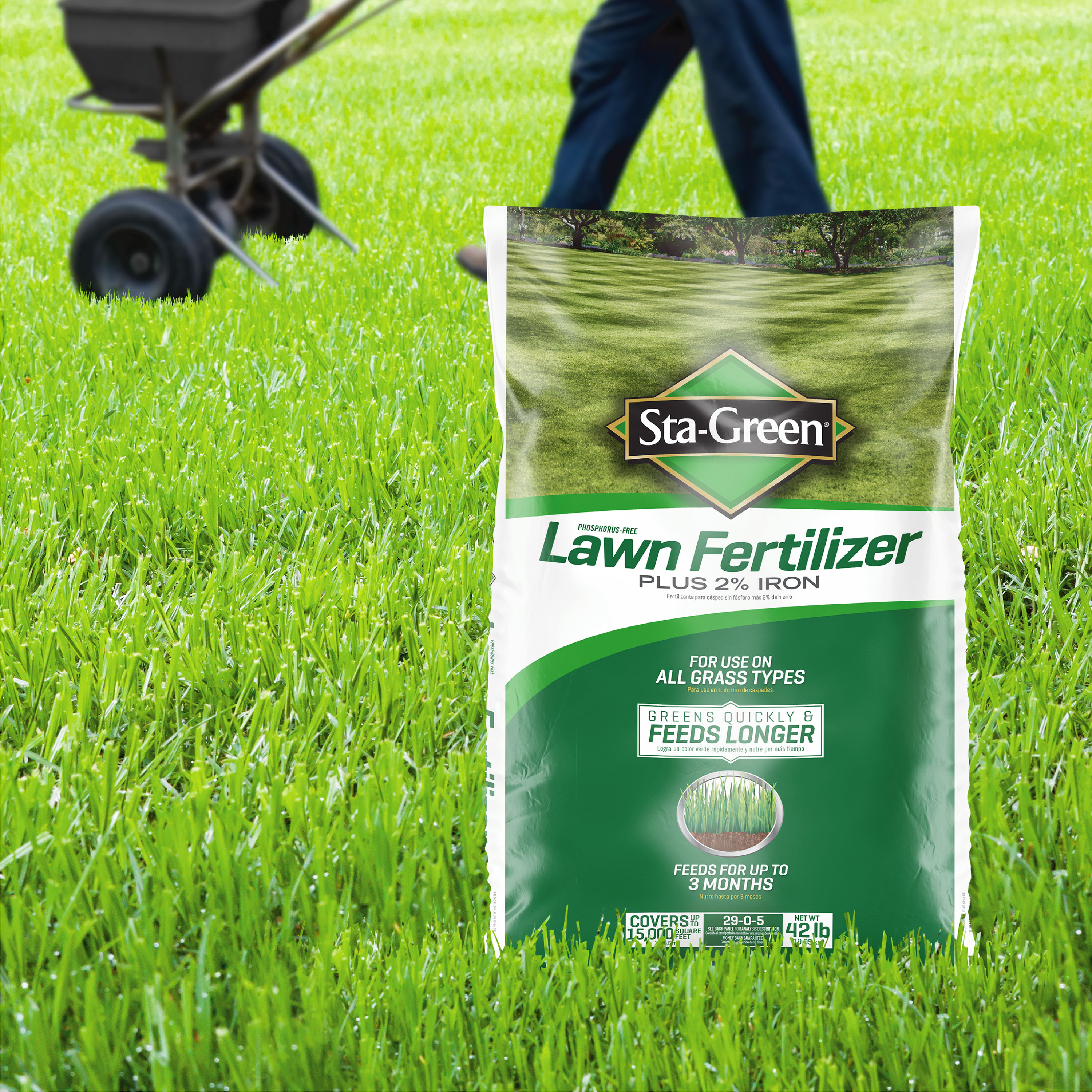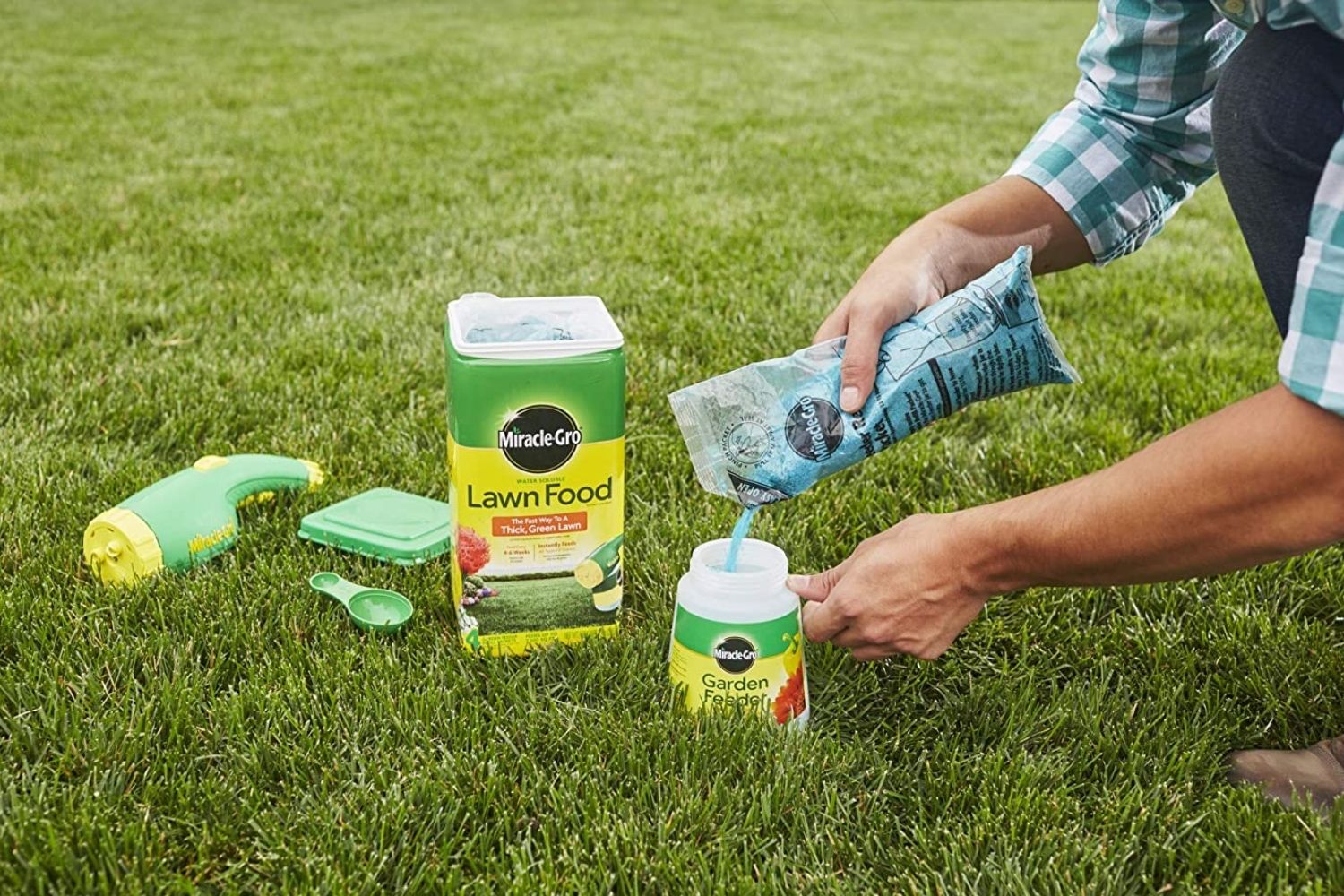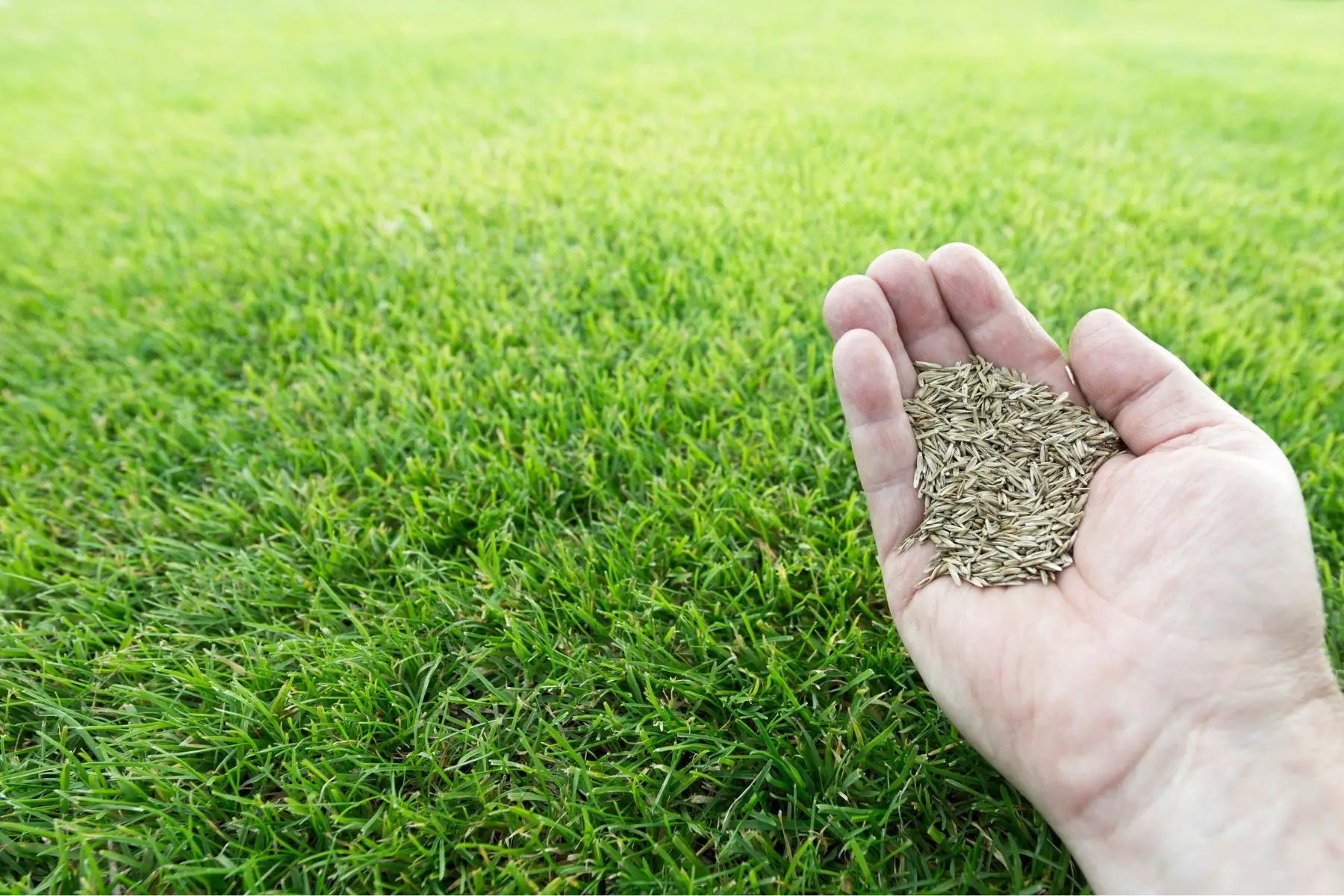Home>Gardening Tips and Tricks>Eco-Friendly Gardening>What Is The Best Fertilizer For Grass


Eco-Friendly Gardening
What Is The Best Fertilizer For Grass
Modified: January 22, 2024
Discover the top eco-friendly fertilizer for your lawn with our comprehensive guide. Transform your grass into a lush, green oasis using our recommended products and methods.
(Many of the links in this article redirect to a specific reviewed product. Your purchase of these products through affiliate links helps to generate commission for Chicagolandgardening.com, at no extra cost. Learn more)
Table of Contents
- Introduction
- Understanding the Role of Fertilizers for Grass
- Factors to Consider When Choosing a Fertilizer for Grass
- Different Types of Fertilizers for Grass
- Organic Fertilizers
- Synthetic Fertilizers
- Slow-Release Fertilizers
- Liquid Fertilizers
- Microbial-based Fertilizers
- Choosing the Best Fertilizer for Your Grass
- Application of Fertilizer for Grass
- Frequency of Fertilizer Application
- Proper Fertilizer Techniques for Grass
- Signs of Over-Fertilization
- Conclusion
Introduction
Gardening is not only a fulfilling hobby, but it also has a positive impact on the environment. One way to make your garden eco-friendly is by practicing sustainable gardening techniques, such as using organic fertilizers. When it comes to maintaining a lush and healthy lawn, choosing the right fertilizer is crucial.
Fertilizers provide essential nutrients to grass, promoting growth and overall vitality. However, not all fertilizers are created equal. Some can have negative effects on the environment due to their chemical composition and runoff into water bodies. To minimize these impacts, it is important to opt for eco-friendly fertilizers that are gentle on the earth but still effective in nourishing your grass.
In this article, we will explore the different types of fertilizers available for grass and discuss their pros and cons. We will also provide guidance on choosing the best fertilizer for your specific lawn needs. With the right knowledge, you can create a beautiful and environmentally conscious garden.
Understanding the Role of Fertilizers for Grass
Fertilizers play a crucial role in maintaining the health and vitality of your grass. They provide essential nutrients that may be lacking in the soil, enabling the grass to grow vigorously and resist diseases and pests. Understanding how fertilizers work can help you make informed decisions about which type to use for your lawn.
Grass requires three primary nutrients for optimal growth: nitrogen (N), phosphorus (P), and potassium (K). Nitrogen is responsible for promoting leaf and stem growth, while phosphorus supports root development and overall plant health. Potassium aids in stress tolerance and disease resistance. Most fertilizers are labeled with three numbers indicating the ratio of these nutrients, such as 12-6-8, which means 12% nitrogen, 6% phosphorus, and 8% potassium.
In addition to these primary nutrients, grass also benefits from secondary nutrients like calcium, magnesium, and sulfur. These nutrients are generally present in the soil, but their availability can vary depending on the soil type and pH level. Fertilizers that contain these secondary nutrients can help maintain the balance required for optimal grass growth.
When applying fertilizer, it’s important to understand that more is not necessarily better. Over-fertilizing can lead to nutrient runoff, which can pollute water sources and harm surrounding ecosystems. Additionally, excessive nitrogen can promote excessive blade growth, making your lawn more susceptible to disease and attracting pests.
By using the right fertilizer in appropriate quantities, you can strike a balance that promotes healthy grass growth without harming the environment. In the next sections, we will explore the different types of fertilizers available and their specific benefits and drawbacks.
Factors to Consider When Choosing a Fertilizer for Grass
Choosing the right fertilizer for your grass involves considering several important factors. Each lawn is unique, and understanding these factors will ensure that you select the most suitable fertilizer for your specific needs. Here are some key considerations to keep in mind:
- Grass Type: Different grass species have varying nutrient requirements. For example, cool-season grasses like Kentucky bluegrass and fescue may have different needs compared to warm-season grasses such as Bermuda grass or St. Augustine grass. Determine the type of grass you have and choose a fertilizer that caters to its specific nutrient needs.
- Soil Composition: The composition of your soil plays a significant role in nutrient availability. Conduct a soil test to determine its pH level and nutrient content. Some fertilizers are designed for specific soil types or pH levels, so understanding your soil’s characteristics will help you select the most effective fertilizer.
- Nutrient Ratio: Fertilizers are formulated with different ratios of nitrogen, phosphorus, and potassium. Pay attention to these ratios and choose a fertilizer that matches the nutrient requirements of your grass. For example, if your grass requires more phosphorus for root development, opt for a fertilizer with a higher phosphorus content.
- Slow-Release vs. Quick-Release: Fertilizers can be categorized as either slow-release or quick-release. Slow-release fertilizers break down gradually, providing a steady supply of nutrients over an extended period. Quick-release fertilizers provide an immediate nutrient boost but are quickly depleted. Consider your lawn’s needs, as well as your maintenance schedule, when selecting between these two types.
- Environmental Impact: Eco-friendliness is a crucial consideration when choosing a fertilizer. Traditional synthetic fertilizers tend to have a higher risk of runoff and can contribute to water pollution. Look for organic or natural fertilizers that are derived from plant or animal sources and have minimal environmental impact.
By taking these factors into account, you can make an informed decision about the fertilizer that will best support the health and vitality of your grass. In the next sections, we will explore the different types of fertilizers available on the market.
Different Types of Fertilizers for Grass
When it comes to fertilizing your lawn, there are several different types of fertilizers to choose from. Each type has its own unique characteristics and benefits. Understanding the differences between these fertilizers can help you select the most appropriate one for your grass. Here are some of the most common types of fertilizers:
- Organic Fertilizers: Organic fertilizers are derived from natural sources such as compost, animal manure, and plant-based materials. They provide a slow and steady release of nutrients, nourishing the grass over an extended period. Organic fertilizers improve soil health and promote microbial activity, resulting in long-term benefits for your lawn. They are also environmentally friendly, as they pose a lower risk of water pollution and help support sustainable gardening practices.
- Synthetic Fertilizers: Synthetic fertilizers are chemically manufactured and often contain a higher concentration of nutrients compared to organic fertilizers. They provide quick and immediate results, making them ideal for correcting nutrient deficiencies or addressing specific issues in your lawn. However, synthetic fertilizers can be more prone to nutrient runoff and may have a negative impact on the environment if used improperly. It is important to follow the application instructions carefully and avoid overuse, especially near water sources.
- Slow-Release Fertilizers: Slow-release fertilizers, as the name suggests, release nutrients gradually over an extended period. They are often coated or encapsulated to control the release rate. These fertilizers are beneficial because they deliver nutrients to the grass consistently, reducing the risk of over-fertilization and providing long-lasting results. Slow-release fertilizers are particularly useful for homeowners who prefer a low-maintenance approach or have busy schedules.
- Liquid Fertilizers: Liquid fertilizers come in liquid form and are usually mixed with water for application. They provide quick and efficient nutrient delivery to the grass. Liquid fertilizers are also easily absorbed by the grass blades and roots, allowing for rapid results. They are excellent for use as a foliar spray or for providing a boost of nutrients during stressful periods such as drought or excessive heat.
- Microbial-based Fertilizers: Microbial-based fertilizers contain beneficial microorganisms like bacteria and fungi that promote healthy soil and plant growth. These microorganisms help improve nutrient availability, enhance soil structure, and protect against diseases. Microbial-based fertilizers work in harmony with the ecological balance of your lawn and are particularly beneficial for organic gardeners who value sustainable practices.
Each type of fertilizer has its own advantages and considerations. It is essential to evaluate your lawn’s specific needs and your gardening preferences when choosing the most suitable fertilizer. In the next sections, we will further explore the benefits and application techniques of these fertilizers.
Organic Fertilizers
Organic fertilizers are a popular choice among eco-conscious gardeners due to their natural composition and sustainable benefits. Derived from plant-based materials, animal manure, or compost, organic fertilizers offer a range of nutrients that promote healthy grass growth.
One of the key benefits of organic fertilizers is their slow-release nature. They gradually break down, providing a steady supply of nutrients over an extended period. This slow-release property ensures that the grass is nourished consistently, reducing the risk of over-fertilization and minimizing nutrient runoff.
In addition to providing essential nutrients, organic fertilizers improve the soil structure and enhance its water-holding capacity. They stimulate microbial activity, promoting a healthy soil ecosystem and supporting the growth of beneficial bacteria and fungi. This microbial activity aids in nutrient cycling, making organic fertilizers a valuable addition to sustainable gardening practices.
Unlike synthetic fertilizers, organic fertilizers have minimal impact on the environment. They pose a lower risk of water pollution and help maintain a healthy balance in local ecosystems. Since organic fertilizers are derived from natural sources, they are safe for children, pets, and wildlife.
There are various types of organic fertilizers available, each with its own nutrient composition. For example, compost is a well-known organic fertilizer that enriches the soil with a wide range of nutrients while improving its structure. Animal manure, such as cow or chicken manure, is also widely used for its nutrient content and soil conditioning properties.
When using organic fertilizers, it is important to follow the application instructions carefully. Apply them evenly across the lawn and water thoroughly to ensure proper distribution. Organic fertilizers are generally applied in larger quantities compared to synthetic fertilizers due to their lower nutrient concentration. Regular application of organic fertilizers can lead to healthier, greener grass that is more resilient to pest and disease attacks.
Overall, organic fertilizers offer a natural and sustainable approach to fertilizing your grass. They provide essential nutrients, improve soil health, and reduce environmental impact. Incorporating organic fertilizers into your lawn care routine will not only benefit your grass but also contribute to a healthier and more balanced ecosystem.
Synthetic Fertilizers
Synthetic fertilizers, also known as chemical or inorganic fertilizers, are widely used in lawn care due to their convenience and immediate results. These fertilizers are manufactured using synthetic compounds that provide a concentrated dose of nutrients to the grass.
One of the advantages of synthetic fertilizers is their high nutrient concentration. They typically contain higher levels of nitrogen, phosphorus, and potassium compared to organic fertilizers. This concentrated nutrient content makes synthetic fertilizers particularly effective for correcting nutrient deficiencies or providing a quick boost to the grass.
Another benefit of synthetic fertilizers is their fast-release nature. They dissolve quickly in water, allowing the grass to absorb the nutrients rapidly. This quick action can lead to noticeable improvements in grass health and appearance in a short timeframe.
However, it is important to use synthetic fertilizers with caution. The fast-release nature of these fertilizers means that they can be easily overused, potentially resulting in nutrient runoff and water pollution. Excessive nitrogen can also lead to excessive blade growth, making the grass more susceptible to diseases and attracting pests.
To minimize the environmental impact of synthetic fertilizers, it is crucial to follow the application instructions carefully. Apply them sparingly and evenly across the lawn, and avoid application near water sources to prevent runoff. It is also advisable to water the grass after applying synthetic fertilizers to ensure proper absorption and reduce the risk of nutrient leaching.
Synthetic fertilizers are available in different formulations, such as granular or water-soluble forms. Granular fertilizers are commonly spread on the soil and require watering to activate the nutrients. Water-soluble fertilizers, on the other hand, can be dissolved in water and applied as a liquid spray.
When using synthetic fertilizers, it is important to consider the specific nutrient requirements of your grass. Different formulations and ratios of nitrogen, phosphorus, and potassium are available to suit various grass types and growth stages. Regular soil testing can help determine the appropriate nutrient balance for your lawn.
In summary, synthetic fertilizers offer a quick and efficient way to provide nutrients to your grass. They have a high nutrient concentration and deliver rapid results. However, proper application and responsible use are essential to minimize the environmental impact. Consider the specific needs of your lawn and follow the instructions for best results.
Slow-Release Fertilizers
Slow-release fertilizers are a popular choice among homeowners who prefer a low-maintenance approach to lawn care. As the name suggests, these fertilizers release nutrients gradually over an extended period, providing a steady supply of nourishment to the grass.
One of the main benefits of slow-release fertilizers is their prolonged nutrient release. They are designed to break down slowly, allowing the grass to receive a continuous supply of nutrients over several weeks or even months. This slow-release property ensures that the grass remains nourished without the risk of over-fertilization or nutrient runoff.
The controlled-release mechanism of these fertilizers is usually achieved through a protective coating or encapsulation. This coating controls the release rate, preventing the nutrients from being released too quickly. Slow-release fertilizers are particularly useful in areas with frequent or heavy rainfalls, as they minimize the leaching of nutrients from the soil.
Compared to quick-release fertilizers, slow-release fertilizers provide long-lasting results. They promote steady and sustained grass growth, improve root development, and enhance overall lawn health. This consistent nutrient supply can also improve the grass’s ability to withstand environmental stressors such as drought, temperature fluctuations, and disease.
Another advantage of slow-release fertilizers is their convenience. Since they release nutrients gradually, there is no need for frequent applications. This saves time and effort, making them ideal for homeowners with busy schedules or those who prefer a hands-off approach to lawn care.
It is important to note that slow-release fertilizers may have a higher initial cost compared to quick-release fertilizers. However, their long-lasting effects and reduced need for frequent applications can offset this cost over time.
When using slow-release fertilizers, it is crucial to follow the application instructions provided by the manufacturer. Apply them evenly across the lawn, ensuring proper coverage. It is also recommended to water the grass after application to activate the nutrients and aid in their absorption.
Overall, slow-release fertilizers are an excellent choice for homeowners seeking consistent and long-lasting results. They provide a slow and steady release of nutrients, promote healthy grass growth, and require less frequent application. Consider using slow-release fertilizers to achieve a lush and vibrant lawn with minimal effort.
Liquid Fertilizers
Liquid fertilizers are a popular choice among gardeners due to their ease of use and rapid nutrient absorption. These fertilizers come in liquid form and are typically mixed with water for application. Liquid fertilizers offer several advantages that make them a convenient option for feeding and nourishing grass.
One of the main benefits of liquid fertilizers is their quick and efficient nutrient delivery. Since they are in liquid form, the nutrients are readily available for the grass to absorb through both the foliage and the roots. This fast action allows the grass to benefit from an immediate nutrient boost, leading to noticeable results in a short period.
The absorption rate of liquid fertilizers is generally higher compared to granular or slow-release fertilizers. The liquid form allows for better penetration into the soil and nutrient uptake by the grass. This makes liquid fertilizers an excellent choice for addressing specific nutrient deficiencies or providing a quick nutrient boost during periods of stress, such as drought or extreme temperatures.
Another advantage of liquid fertilizers is their versatility in application methods. They can be applied as a foliar spray, which means spraying the fertilizer directly onto the grass blades. This method allows for efficient nutrient absorption through the leaves and can provide quick results. Liquid fertilizers can also be applied through irrigation systems or mixed directly into the watering can for even distribution.
It is important to follow the application instructions provided by the manufacturer when using liquid fertilizers. Dilute the fertilizer according to the recommended ratio and apply it evenly across the lawn. Take care not to overapply, as this can lead to nutrient imbalances and potential damage to the grass.
Another consideration with liquid fertilizers is their relatively short duration of effectiveness. They may require more frequent applications compared to slow-release or granular fertilizers, especially during periods of rapid grass growth or heavy rainfall. Regular monitoring of the grass’s nutrient needs and adjusting the application schedule accordingly is essential for optimal results.
Overall, liquid fertilizers offer a convenient and efficient way to deliver nutrients to your grass. Their quick absorption, versatility in application, and immediate results make them a popular choice among gardeners. Consider using liquid fertilizers for targeted feeding or to provide a quick nutrient boost for a healthy and vibrant lawn.
Microbial-based Fertilizers
Microbial-based fertilizers have gained popularity in recent years as more gardeners seek sustainable and environmentally friendly gardening practices. These fertilizers contain beneficial microorganisms such as bacteria and fungi, which work in harmony with the soil and plants to promote healthy grass growth.
One of the key advantages of microbial-based fertilizers is their ability to improve soil health. The beneficial microorganisms in these fertilizers help break down organic matter, releasing nutrients and making them more available to the grass. They also enhance soil structure, improving aeration and water retention, which in turn promotes root development and overall plant health.
The microorganisms in microbial-based fertilizers form symbiotic relationships with the grass roots, forming a network known as the rhizosphere. This network helps improve nutrient absorption and uptake by the grass, making it more efficient in utilizing the available nutrients in the soil.
In addition to nutrient availability, microbial-based fertilizers also play a role in disease prevention. Beneficial bacteria and fungi compete with harmful pathogens, reducing the risk of diseases and helping to keep the grass healthy. They can also contribute to improved stress tolerance, allowing the grass to withstand environmental challenges such as drought or extreme temperatures.
Microbial-based fertilizers are particularly beneficial for organic gardeners who prioritize sustainable gardening practices. They are derived from natural sources and pose minimal risk to the environment. The use of these fertilizers supports the development of a diverse and thriving soil ecosystem, with a healthy balance of microorganisms.
When applying microbial-based fertilizers, it is essential to follow the instructions provided by the manufacturer. Apply them evenly across the lawn, ensuring proper coverage. Depending on the specific product, microbial-based fertilizers may need to be watered and activated after application to ensure the microorganisms establish themselves in the soil.
It is important to note that microbial-based fertilizers may require additional time to show visible results compared to synthetic or quick-release fertilizers. The benefits they provide are often long-term, focusing on improving soil health and enhancing the overall resilience of the grass.
Overall, microbial-based fertilizers offer a natural and sustainable approach to fertilizing your grass. They promote soil health, enhance nutrient availability, and contribute to disease prevention. Consider incorporating microbial-based fertilizers into your lawn care routine for a thriving and resilient lawn that aligns with eco-friendly gardening practices.
Choosing the Best Fertilizer for Your Grass
Choosing the best fertilizer for your grass involves considering several factors to ensure optimal growth and health. Here are some key considerations to help you make an informed decision:
- Grass Type: Different grass species have varying nutrient requirements. Identify the type of grass you have to select a fertilizer that matches its specific needs.
- Soil Composition: Conduct a soil test to determine the pH level and nutrient content of your soil. Choose a fertilizer that addresses any nutrient deficiencies and complements the soil composition.
- Nutrient Ratio: Consider the nutrient ratio of the fertilizer. The three primary nutrients—nitrogen, phosphorus, and potassium—should be balanced according to your grass’s needs.
- Fertilizer Type: Decide between organic and synthetic fertilizers based on your preferences and gardening practices. Organic fertilizers are environmentally friendly, while synthetic fertilizers provide quicker results.
- Application Method: Determine whether you prefer granular, liquid, slow-release, or microbial-based fertilizers. Consider factors such as convenience, nutrient absorption rates, and environmental impact.
- Environmental Impact: Aim for an eco-friendly fertilizer that minimizes the risk of nutrient runoff and supports sustainable gardening practices.
- Cost: Consider your budget and the long-term effectiveness of the fertilizer. While some fertilizers may have a higher initial cost, they may provide greater benefits over time.
By evaluating these factors, you can choose the best fertilizer that caters to the specific needs of your grass, aligns with your gardening practices, and promotes sustainable lawn care.
It is also important to note that fertilization should be part of a broader lawn care routine that includes proper watering, mowing, and maintenance practices. Regular monitoring of your lawn’s condition will help determine the appropriate timing and frequency of fertilizer applications.
Remember to always follow the manufacturer’s instructions for proper application and dosage. Over-fertilizing can harm your grass and the environment, while under-fertilizing may not provide the desired results.
By selecting the right fertilizer and practicing proper lawn care techniques, you can have a healthy, vibrant, and sustainable lawn that enhances the beauty of your outdoor space.
Application of Fertilizer for Grass
The proper application of fertilizer is crucial to ensure that your grass receives the necessary nutrients for optimal growth. Here are some key guidelines to follow when applying fertilizer:
- Read the Instructions: Carefully read and follow the instructions provided by the fertilizer manufacturer. This includes the recommended application rate, timing, and any specific instructions for the type of fertilizer you are using.
- Timing: Apply fertilizer at the appropriate time. In general, it is best to fertilize in the early spring or fall when grass is actively growing. Avoid fertilizing during periods of drought or high heat, as this can stress the grass and lead to nutrient loss.
- Even Coverage: Apply the fertilizer evenly across the lawn to ensure uniform nutrient distribution. Use a spreader for granular fertilizers and follow the recommended settings for the desired application rate. For liquid fertilizers, apply using a sprayer or watering can, making sure to cover the entire lawn.
- Watering: Water the lawn after applying the fertilizer. This helps activate the nutrients and ensures their absorption by the grass roots. Watering also helps to spread the fertilizer evenly and minimizes the risk of nutrient runoff.
- Avoid Overlapping: Be mindful of overlapping when applying granular fertilizers. Overlapping can lead to excessive nutrient concentrations in certain areas, potentially damaging the grass. To avoid this, follow a pattern and make sure each pass overlaps slightly to ensure even coverage.
- Environmental Considerations: Be mindful of the environment when applying fertilizer. Avoid applying fertilizer near water bodies or storm drains to prevent nutrient runoff into water sources. If there are sensitive areas in your yard, consider creating a buffer zone or applying a reduced amount of fertilizer to minimize environmental impact.
Remember, fertilizers are not a one-time solution. Regular and consistent application is necessary to maintain the health and vitality of your lawn. However, it is essential to strike a balance and avoid over-fertilizing, as excessive nutrients can cause harm to the grass and contribute to environmental issues.
Proper fertilization, combined with other lawn care practices such as regular watering, mowing, and aeration, will help create a lush, green, and thriving lawn that you can enjoy throughout the year.
Frequency of Fertilizer Application
The frequency of fertilizer application for your grass depends on several factors, including the type of fertilizer, grass species, soil condition, and climate. Here are some guidelines to help determine the right frequency for fertilizing your lawn:
- Soil Test: Conduct a soil test to determine the nutrient levels and pH of your soil. This test will provide valuable information on any nutrient deficiencies or imbalances, helping you determine the frequency and type of fertilizer required.
- Grass Growth Rate: Different grass species have varying growth rates, which affect their nutrient requirements. Fast-growing grasses may need more frequent fertilization compared to slower-growing varieties.
- Seasonal Timing: Fertilize in accordance with the grass’s growth cycle. In general, cool-season grasses benefit from fertilization in early spring and fall, while warm-season grasses benefit from fertilization during the active growing season.
- Fertilizer Type: Consider the type of fertilizer you are using. Slow-release fertilizers release nutrients gradually, providing longer-lasting effects and requiring less frequent applications. Quick-release fertilizers may need to be reapplied more often.
- Environmental Factors: Take into account environmental conditions such as rainfall and temperature. Excessive rainfall can wash away nutrients, requiring more frequent fertilization. Likewise, high heat or drought may necessitate additional applications to support grass health.
- Lawn Condition: Regularly monitor your lawn for signs of nutrient deficiencies, such as yellowing, slow growth, or sparse patches. If these signs are present, it may indicate the need for more frequent or targeted fertilization.
A balanced approach to fertilizer application is crucial. While proper fertilization promotes healthy grass growth, over-fertilizing can damage the lawn and contribute to environmental issues. Applying too much fertilizer can lead to excessive nutrient concentrations in the soil, potentially causing nutrient imbalances, leaching, and runoff.
Remember to always follow the instructions provided by the fertilizer manufacturer. This includes recommended application rates, timing, and any specific guidelines for your type of grass or fertilizer.
The key is to find a balance that meets the nutrient requirements of your grass without harming the environment. Regular monitoring, soil testing, and adjusting the frequency of fertilizer applications as needed will help maintain a lush, vibrant, and sustainable lawn.
Proper Fertilizer Techniques for Grass
Proper techniques for applying fertilizer to your grass are essential to ensure effective nutrient uptake and minimize the risk of environmental harm. Follow these guidelines to employ the best practices when fertilizing your lawn:
- Measure Accurately: Use a calibrated spreader or measuring cup to ensure accurate application of the fertilizer. This helps avoid over- or under-fertilization, leading to optimal nutrient distribution.
- Apply at the Right Time: Choose appropriate timing for fertilizer application based on your grass type and climatic conditions. Apply fertilizers when the grass is actively growing and not during periods of drought, heat stress, or dormancy.
- Avoid Windy Days: Apply fertilizer on calm days to prevent it from drifting and causing uneven distribution. Wind can also carry fertilizer particles to non-target areas, potentially causing harm to plants and water bodies.
- Uniform Coverage: Apply fertilizer evenly across the lawn to ensure uniform nutrient distribution. Avoid overlap and gaps in application, which can lead to uneven growth and coloration.
- Water the Lawn: Water the grass after fertilizer application to assist in nutrient uptake and reduce nutrient runoff. Watering also helps to dissolve granular fertilizers and activate the nutrients for absorption by the roots.
- Maintain Equipment: Regularly clean and maintain your spreader or sprayer to ensure accurate and consistent application. Improperly functioning equipment may result in uneven fertilizer distribution and suboptimal grass growth.
- Follow Local Regulations: Be aware of any local regulations or ordinances regarding fertilizer use, especially near water bodies. Some areas have restrictions on fertilizer application to minimize nutrient runoff and protect water quality.
- Protect Non-Target Areas: When applying fertilizer near driveways, sidewalks, or non-target plants, take precautions to avoid direct contact. Fertilizer runoff can harm these areas and cause unintended damage.
- Proper Cleanup: After fertilizing, clean any fertilizer residues on hard surfaces to prevent accidental runoff. This will help protect the environment and maintain the aesthetic appeal of your outdoor spaces.
By following these proper fertilizer techniques, you can ensure that your grass receives the necessary nutrients for healthy growth while minimizing the risk of environmental impact. Remember to always read and follow the instructions on the fertilizer packaging, as specific guidelines may vary depending on the brand and type of fertilizer.
Integrating these techniques into your lawn care routine will help create a thriving, lush, and sustainable lawn that you can enjoy throughout the seasons.
Signs of Over-Fertilization
While fertilizing your lawn is important for its health and growth, it is possible to over-fertilize, which can lead to negative consequences. Recognizing the signs of over-fertilization is crucial to address the issue before it causes further damage. Here are some common signs to look out for:
- Burned Grass: One of the most noticeable signs of over-fertilization is grass that appears burnt or scorched. The edges of the blades may turn brown or yellow, resembling damage caused by heat or drought stress.
- Excessive Growth: Over-fertilized grass may exhibit excessive growth, with long and rapidly growing blades. This lush growth is often accompanied by a weakened root system, leaving the grass more susceptible to diseases and pests.
- Patchy or Uneven Growth: Over-fertilization can result in patchy or uneven grass growth. Some areas may show sparse growth or have stunted, distorted blades, while others may have excessive growth and appear healthier.
- Thinning or Yellowing Grass: Instead of vibrant green, over-fertilized grass may turn yellow or pale green. This yellowing can indicate nutrient imbalances or stress caused by excessive fertilizer application.
- Increased Weed Growth: Over-fertilized lawns can create an environment where weeds thrive. The rapid growth of grass due to excess nutrients can weaken its competitive advantage against invasive weeds.
- Excessive Runoff: If you notice an excessive amount of fertilizer runoff after watering or rainfall, it may indicate that you are applying fertilizers beyond what the grass can absorb. This runoff can result in pollution of local water bodies.
- Algal Blooms or Water Pollution: Over-fertilization can contribute to nutrient pollution in water bodies. If you observe frequent algal blooms or notice an excessive growth of aquatic plants in nearby ponds or streams, it may be a sign of nutrient runoff from over-fertilized lawns.
If you notice any of these signs of over-fertilization, it is essential to take corrective measures. First, thoroughly flush the area with water to help leach out the excess nutrients. Adjust your fertilization practices by reducing the amount of fertilizer used or adjusting the frequency of application to align with the grass’s actual needs.
Prevention is key in avoiding over-fertilization. Always follow the recommended application rates and timings specified on the fertilizer packaging. Conducting a soil test to determine the nutrient levels and pH of your soil can also help you apply the appropriate amount of fertilizer without exceeding the grass’s requirements.
By monitoring your lawn for signs of over-fertilization and adjusting your practices accordingly, you can maintain a healthy, vibrant lawn while minimizing the risk of nutrient imbalances and environmental harm.
Conclusion
Eco-friendly gardening practices play a vital role in maintaining a healthy and sustainable environment. When it comes to fertilizing your grass, choosing the right fertilizer and applying it correctly are essential for promoting optimal growth while minimizing negative impacts on the ecosystem.
Understanding your grass’s specific needs, soil composition, and environmental factors are key factors when selecting a fertilizer. Whether you opt for organic fertilizers that nourish the soil and promote long-term soil health or synthetic fertilizers that provide quick results, it is important to strike a balance that meets your lawn’s requirements and minimizes environmental harm.
Proper techniques for fertilizer application, such as measuring accurately, applying at the right time, and ensuring uniform coverage, are crucial for effective nutrient uptake. Regular monitoring of your lawn’s condition and adjusting your fertilizer practices accordingly can help prevent over-fertilization and its associated issues.
Remember to follow local regulations regarding fertilizer use and protect non-target areas near water bodies to minimize environmental impact. By implementing these guidelines, you can foster a thriving and sustainable lawn that enhances the beauty of your outdoor space.
Incorporating eco-friendly gardening practices, such as composting, proper watering, and natural pest control methods, alongside responsible fertilizer use, will contribute to the overall health and well-being of your lawn and the surrounding environment.
By taking a holistic approach to lawn care, you can create a lush and vibrant grassy oasis while minimizing harm to the environment. So, whether you choose organic or synthetic fertilizers, employ proper techniques, and maintain a balance that keeps your grass nourished and the ecosystem thriving.









